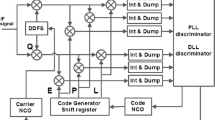Abstract
Noncoherent early-late processing (NELP) code tracking loops are often implemented using digital hardware for digital global positioning system (GPS) receivers. Noncommensurate sampling technology is widely used because it is viewed as an effective solution to cope with the drawback of digital effects. However, the relationship between the sampling rate and auto-correlation function (ACF) is not adequately characterized by traditional analysis. The principles for selecting the sampling rate are still not apparent. In order to solve this problem, we first analyzed the effects of different sampling rates on ACF and obtained the analytical form of a discrete auto-correlation function (DACF) for a noncommensurate sampling rate. Based on the result, the relationship between the step variation in DACF and NELP parameters such as sampling rate, integration time, and correlator spacing was determined. The maximum step variation size of DACF was also determined. However, considering the actual situation, additional factors such as code Doppler shift, precorrelation filter, and thermal noise may degrade the step variation of DACF. The relationship between the step variation and these factors was analyzed separately. An appropriate sampling rate and appropriate correlator spacing were proposed to achieve the typical accuracy of measurement. The numerical simulation verified the validity of the above theoretical analyses, and finally, the conclusions and design constraints for the digital GPS receiver are summarized.
Similar content being viewed by others
References
Meyr H. Delay-lock tracking of stochastic signals. IEEE Trans Commun, 1976, 24: 331–339
Polydoros A, Weber C. Analysis and optimization of correlative codetracking loops in spread-spectrum systems. IEEE Trans Commun, 1985, 33: 30–43
Simon M. Noncoherent pseudonoise code tracking performance of spread spectrum receivers. IEEE Trans Commun, 1977, 25: 327–345
Betz J W, Kolodziejski K R. Generalized theory of code tracking with an early-late discriminator Part I: Lower bound and coherent processing. IEEE Trans Aerosp Electron Syst, 2009, 45: 1538–1556
Betz J W, Kolodziejski K R. Generalized theory of code tracking with an early-late discriminator Part II: Noncoherent processing and numerical results. IEEE Trans Aerosp Electron Syst, 2009, 45: 1557–1564
Thomas J. Signal-processing theory for the TurboRogue receiver. NASA STI/Recon Technical Report, 1995
Quirk K J, Srinivasan M. Analysis of sampling and quantization effects on the performance of PN code tracking loops. In: IEEE International Conference on Conference: Communications, 2002. New York: IEEE, 2002. 1480–1484
Liu L, Amin M G. Performance analysis of GPS receivers in non-Gaussian noise incorporating precorrelation filter and sampling rate. IEEE Trans Signal Process, 2008, 56: 990–1004
Quirk K J, Srinivasan M. PN code tracking using noncommensurate sampling. IEEE Trans Commun, 2006, 54: 1845–1856
Yuan C, Yuan H, Xu Y, et al. The study on pseudorange error caused by sampling process for GNSS Receiver. In: Proceedings of 2013 China Satellite Navigation Conference (CSNC). Berlin, Heidelberg: Springer, 2013. 525–535
Yang J, Yang Y K, Li J S, et al. A novel satellite-equipped receiver for autonomous monitoring of GNSS navigation signal quality. Sci China Tech Sci, 2016, 59: 1137–1146
Jin Z, Zhang C, Xu Z, et al. Simple approach to determining parameters of noncommensurate sampling for optimal pseudo-noise code phase delay discrimination. Electron Lett, 2014, 50: 283–284
Lo Presti L, Zhu X, Fantino M, et al. GNSS signal acquisition in the presence of sign transition. IEEE J Sel Top Signal Process, 2009, 3: 557–570
Liu Y, Ran Y, Ke T, et al. Code tracking performance analysis of GNSS signal in the presence of CW interference. Signal Process, 2011, 91: 970–987
Balaei A T, Dempster A G, Presti L L. Characterization of the effects of CW and pulse CW interference on the GPS signal quality. IEEE Trans Aerosp Electron Syst, 2009, 45: 1418–1431
Kaplan E, Hegarty C. Understanding GPS: Principles and Applications. 2nd ed. London: Artech House, 2005. 141–148
Liu H, Zhang R F, Liu J N, et al. Time synchronization in communication networks based on the Beidou foundation enhancement system. Sci China Tech Sci, 2016, 59: 9–15
Author information
Authors and Affiliations
Corresponding author
Rights and permissions
About this article
Cite this article
Yang, J., Yang, Y., Li, J. et al. Analysis of noncommensurate sampling effects on the performance of PN code tracking loops. Sci. China Technol. Sci. 61, 893–905 (2018). https://doi.org/10.1007/s11431-017-9199-8
Received:
Accepted:
Published:
Issue Date:
DOI: https://doi.org/10.1007/s11431-017-9199-8




